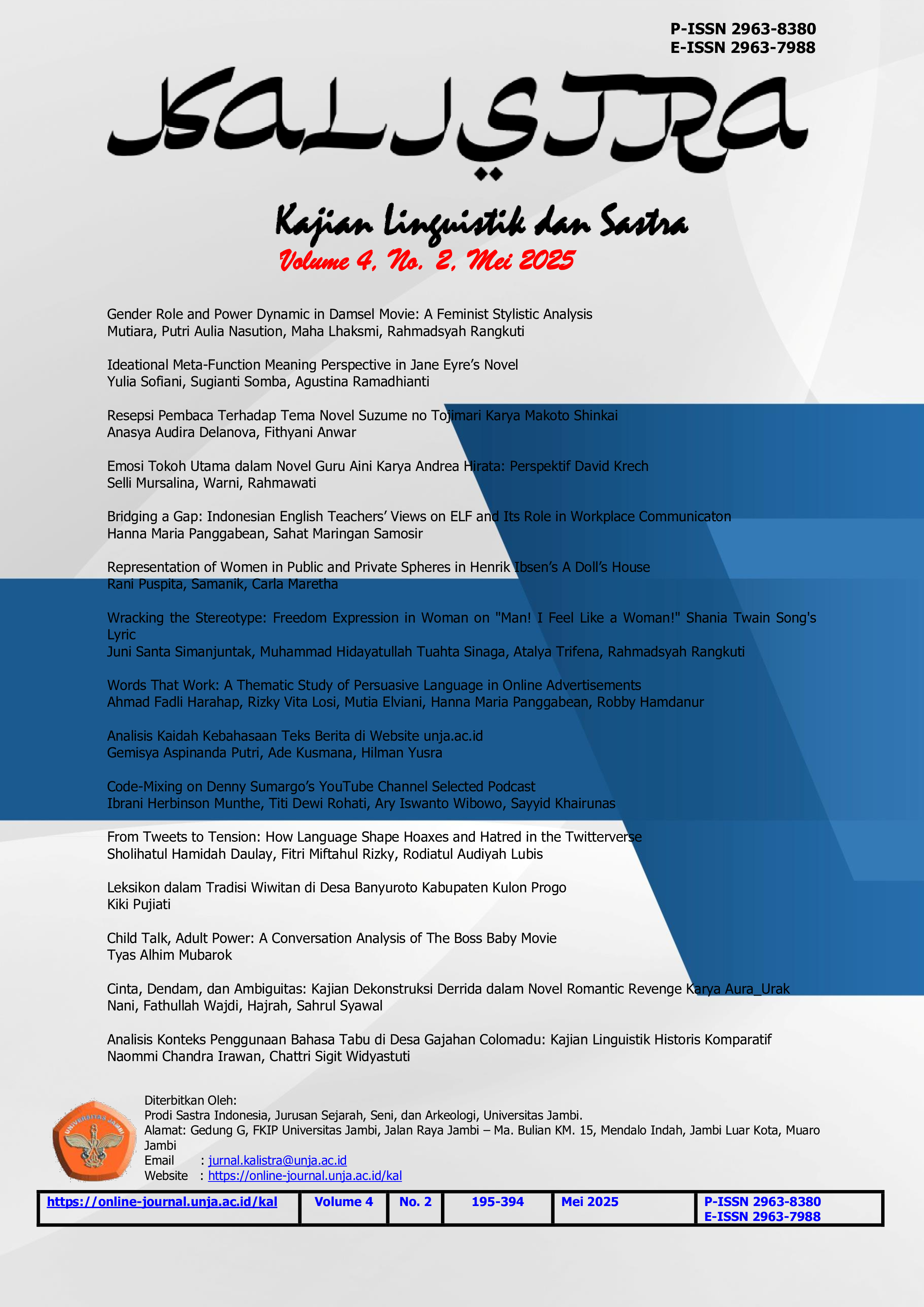Representation of Women in Public and Private Spheres in Henrik Ibsen’s A Doll’s House
DOI:
https://doi.org/10.22437/kalistra.v4i2.42259Keywords:
Feminism, Public and Private Sphere, A Doll's HouseAbstract
This study examines Henrik Ibsen’s A Doll’s House through feminist frameworks, focusing on Nora’s navigation of 19th-century Norway’s public and private spheres. Using Simone de Beauvoir’s concept of “the Other” and Judith Butler’s theory of performativity, the analysis reveals how patriarchal norms shaped Nora’s subjugation and ultimate rebellion. The study highlights the play’s enduring relevance in advocating for gender equality and contributes to feminist literary criticism by exploring the intersection of gender, power, and societal norms. While previous studies have extensively analyzed Nora's character, this study explores how the play's portrayal of the duality of public and private spaces shapes Nora's rebellion against societal expectations. Furthermore, this study explores how Ibsen's work continues to resonate with contemporary audiences, highlighting the enduring relevance of his critique of gender inequality and the need for women's empowerment. By examining the enduring power of A Doll's House, the article argues that Ibsen's play continues to serve as a vital tool for understanding and challenging the structures that perpetuate gender inequality in the modern world.
Abstrak
Penelitian ini membahas drama Henrik Ibsen, Rumah Boneka, dari sudut pandang feminis. Kita akan melihat bagaimana Nora berjuang di tengah-tengah kehidupan publik dan pribadi di Norwegia abad ke-19. Dengan menggunakan konsep "The Other" dari Simone de Beauvoir dan teori performativitas Judith Butler, kita akan memahami bagaimana norma-norma patriarki menekan Nora dan akhirnya memicu pemberontakannya. Penelitian ini menunjukkan betapa pentingnya drama ini dalam memperjuangkan kesetaraan gender, dan menambah wawasan kritik sastra feminis dengan melihat hubungan antara gender, kekuasaan, dan norma-norma sosial. Meskipun sudah banyak penelitian yang membahas karakter Nora, penelitian ini berfokus pada bagaimana penggambaran kehidupan publik dan pribadi dalam drama tersebut memengaruhi pemberontakan Nora terhadap harapan masyarakat. Penelitian ini juga akan mengeksplorasi bagaimana karya Ibsen masih relevan bagi penonton modern, menekankan kritiknya yang terus aktual tentang ketidaksetaraan gender dan pentingnya pemberdayaan perempuan. Dengan melihat dampak Rumah Boneka yang terus berlanjut, penelitian ini berpendapat bahwa drama Ibsen tetap menjadi alat yang ampuh untuk memahami dan menantang sistem yang menyebabkan ketidaksetaraan gender hingga saat ini.
Downloads
References
Beauvoir, S. de. (1949). The second sex. New York, NY: Alfred A. Knopf.
Butler, J. (1990). Gender trouble: Feminism and the subversion of identity. New York, NY: Routledge.
Çalışkan, O. (2014). Network society and the search for a new public sphere in the context of the public sphere. Maltepe University Journal of Communication, 1(1), 41–62.
Çiftçi, O. (1998). Women and the future at the end of the 20th century. [Further publication details are missing. Provide publisher, journal, or other details if available.]
Fromm, E. (1955). The sane society. New York, NY: Henry Holt and Company.
Ibsen, H. (1879). A doll’s house. Copenhagen: Gyldendal.
Habermas, J. (1989). The structural transformation of the public sphere: An inquiry into a category of bourgeois society (T. Burger & F. Lawrence, Trans.). Cambridge, MA: MIT Press. (Original work published 1962)
Wiseman, M. C. (2010). Nora as a doll in Henrik Ibsen’s A doll’s house. Inquiries Journal, 2(3). Retrieved from http://www.inquiriesjournal.com/
Miles, M. B., Huberman, A. M., & Saldaña, J. (2014). Qualitative data analysis: A methods sourcebook. Thousand Oaks, CA: SAGE Publications.
Mulyana, D. (2018). Metodologi penelitian kualitatif: Paradigma baru ilmu komunikasi dan ilmu sosial lainnya. Bandung: Remaja Rosdakarya.
Ridgeway, C. L. (2011). Framed by gender: How gender inequality persists in the modern world. Oxford: Oxford University Press.
Wienclaw, R. A. (2011). Gender roles and society. Research Starters: Sociology. EBSCO Publishing.
Yersel, A. (2015). "Power rooms" in the context of the relationship between space and power. (Master’s thesis). Istanbul Commerce University Institute of Social Sciences, Istanbul.
Yıldız, E. (2013). Feminist perspectives on public and private spheres. Journal of Gender Studies, 22(4), 395–408.
Downloads
Published
How to Cite
Issue
Section
License
Copyright (c) 2025 Rani Puspita, Samanik Samanik, Carla Maretha

This work is licensed under a Creative Commons Attribution-ShareAlike 4.0 International License.
Kalistra: Kajian Linguistik dan Sastra is licensed under Creative Commons Attribution-ShareAlike 4.0 International License.
Authors who publish their manuscripts in Kajian Linguistik dan Sastra agree to the following terms:
1. The copyright in each article belongs to the author.
2. The author acknowledges that Kajian Linguistik dan Sastra reserves the right to be the first to publish under a Creative Commons Attribution-ShareAlike 4.0 International License (Attribution 4.0 International CC BY-SA 4.0).
3. Authors may submit articles separately, arranging for non-exclusive distribution of manuscripts that have been published in this journal to other versions (e.g., delivery to the author's institutional repository, publication into a book, etc.), acknowledging that the manuscript has been first published in Kajian Linguistik dan Sastra.
















